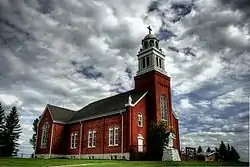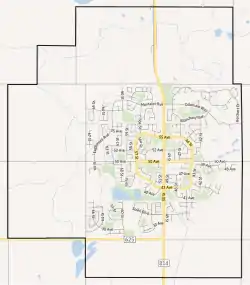Beaumont, Alberta
Beaumont (/ˈboʊmɒnt/ BOH-mont) is a city in Leduc County within the Edmonton Metropolitan Region of Alberta, Canada. It is located at the intersection of Highway 625 and Highway 814, adjacent to the City of Edmonton and 6.0 kilometres (3.7 mi) northeast of the City of Leduc. The Nisku Industrial Park and the Edmonton International Airport are located 4.0 kilometres (2.5 mi) to the west and 8.0 kilometres (5.0 mi) to the southwest respectively.
Beaumont | |
|---|---|
| City of Beaumont Ville de Beaumont | |
 St. Vital Roman Catholic Church in Beaumont | |
 Flag | |
| Motto(s): Life is better in Beaumont! | |
 City boundaries | |
 Beaumont Location in Alberta  Beaumont Location in Canada  Beaumont Location in Leduc County | |
| Coordinates: 53°21′26″N 113°24′53″W | |
| Country | Canada |
| Province | Alberta |
| Region | Edmonton Metropolitan Region |
| Municipal district | Leduc County |
| Founded[1] | 1895 |
| Incorporated[2][3] | |
| • Village | January 1, 1973 |
| • Town | January 1, 1980 |
| • City | January 1, 2019 |
| Government | |
| • Mayor | John Stewart [5] |
| • Governing body | Beaumont City Council
|
| • CAO | Mike Schwirtz |
| • MLA | Brad Rutherford |
| Area (2016)[6] | |
| • Land | 10.47 km2 (4.04 sq mi) |
| Elevation | 735 m (2,411 ft) |
| Population (2016)[6] | |
| • Total | 17,396 |
| • Density | 1,661.1/km2 (4,302/sq mi) |
| • Municipal census (2019) | 19,236[8] |
| Time zone | UTC−7 (MST) |
| • Summer (DST) | UTC−6 (MDT) |
| Forward sortation area | T4X |
| Area codes | 780, 587, 825 |
| Highways | Highway 625 Highway 814 |
| Website | Official website |
Originally a French farming community, Beaumont is now a city with 19,236 people. Its downtown core resembles a French village with unique architecture and red brick walkways. It is named for the "beautiful hill" on which St. Vital Church, built in 1919, is located within the centre of the city. The name was selected in 1895 as part of a petition for a post office.[1]
History
Beaumont incorporated as a village on January 1, 1973, and then as a town on January 1, 1980.[2] On January 1, 2019, Beaumont incorporated as a city.[3]
Demographics
| Year | Pop. | ±% |
|---|---|---|
| 1941 | 65 | — |
| 1951 | 149 | +129.2% |
| 1956 | 121 | −18.8% |
| 1961 | 194 | +60.3% |
| 1966 | 234 | +20.6% |
| 1971 | 337 | +44.0% |
| 1976 | 851 | +152.5% |
| 1981 | 2,638 | +210.0% |
| 1986 | 3,944 | +49.5% |
| 1991 | 5,042 | +27.8% |
| 1996 | 5,810 | +15.2% |
| 2001 | 7,006 | +20.6% |
| 2006 | 8,961 | +27.9% |
| 2011 | 13,284 | +48.2% |
| 2016 | 17,396 | +31.0% |
| Source: Statistics Canada [9][10][11][12][13][14][15][16][17][18][19][20][21][6] | ||
The population of the City of Beaumont according to its 2019 municipal census is 19,236,[8] a change of 2.2% from its 2018 municipal census population of 18,829.[22]
In the 2016 Census of Population conducted by Statistics Canada, Beaumont recorded a population of 17,396 living in 5,633 of its 5,980 total private dwellings, a 31% change from its 2011 population of 13,284. With a land area of 10.47 km2 (4.04 sq mi), it had a population density of 1,661.5/km2 (4,303.3/sq mi) in 2016.[6]
In the 2011 Census, Beaumont had a population of 13,284 living in 4,369 of its 4,566 total dwellings, a 48.2% change from its 2006 population of 8,961. With a land area of 10.5 km2 (4.1 sq mi), it had a population density of 1,265.1/km2 (3,276.7/sq mi) in 2011.[21] The 2011 census also indicated that Beaumont was ranked as the municipality with the seventh-highest population growth between 2006 and 2011.[23]
In 2014, 49.6% of the workforce of Beaumont was employed in the nearby city of Edmonton.[24]
| Visible minority and Aboriginal population (Canada 2016 Census) | |||
|---|---|---|---|
| Population group | Population | % of total population | |
| White | 13,145 | 75.6% | |
| Visible minority group Source:[25] |
South Asian | 685 | 3.9% |
| Chinese | 65 | 0.4% | |
| Black | 370 | 2.1% | |
| Filipino | 235 | 1.4% | |
| Latin American | 135 | 0.8% | |
| Arab | 30 | 0.2% | |
| Southeast Asian | 80 | 0.5% | |
| West Asian | 25 | 0.1% | |
| Korean | 80 | 0.5% | |
| Japanese | 15 | 0.1% | |
| Visible minority, n.i.e. | 35 | 0.2% | |
| Multiple visible minority | 25 | 0.1% | |
| Total visible minority population | 1,780 | 10.2% | |
| Aboriginal group Source:[26] | First Nations | 390 | 2.2% |
| Métis | 665 | 3.7% | |
| Inuit | 25 | 0.1% | |
| Multiple Aboriginal responses | 10 | 0.1% | |
| Aboriginal responses, n.i.e | 15 | 0.1% | |
| Total Aboriginal population | 1,090 | 6.3% | |
| Total population | 17,396 | 100% | |
Economy
The City of Beaumont is a member of the Leduc-Nisku Economic Development Association, an economic development partnership that markets Alberta's International Region[27] in proximity to the Edmonton International Airport.[28]
Arts and culture
Beaumont is home to the Beaumont Blues & Roots Festival (BBRF). Previous performers at the BBRF have included Chantal Kreviazuk, Raine Maida, Corb Lund, Fred Penner, Matt Andersen, Sloan, Powder Blues Band, and the Sheepdogs.[29]
References
- Beaumont History Book Committee (1985). Beaumont : histoire de Beaumont et district, 1885-1960. p. 13. Archived from the original on September 24, 2015. Retrieved May 28, 2013.
- "Location and History Profile: Town of Beaumont" (PDF). Alberta Municipal Affairs. June 17, 2016. p. 36. Retrieved June 19, 2016.
- "Order in Council (O.C.) 395/2018". Government of Alberta. December 11, 2018. Retrieved January 1, 2019.
- "Municipal Officials Search". Alberta Municipal Affairs. September 22, 2017. Retrieved September 25, 2017.
- "Alberta election 2017: Beaumont results". Global News. Erika Tucker. Archived from the original on October 17, 2017. Retrieved October 17, 2017.
- "Population and dwelling counts, for Canada, provinces and territories, and census subdivisions (municipalities), 2016 and 2011 censuses – 100% data (Alberta)". Statistics Canada. February 8, 2017. Retrieved February 8, 2017.
- "Alberta Private Sewage Systems 2009 Standard of Practice Handbook: Appendix A.3 Alberta Design Data (A.3.A. Alberta Climate Design Data by Town)" (PDF) (PDF). Safety Codes Council. January 2012. pp. 212–215 (PDF pages 226–229). Retrieved October 8, 2013.
- "2019 Municipal Census Results" (PDF). City of Beaumont. June 11, 2019. Retrieved June 8, 2019.
- Ninth Census of Canada, 1951. SP-7, Population: Unincorporated villages and hamlets. Dominion Bureau of Statistics. pp. 55–57.
- "Table 6: Population by sex, for census subdivisions, 1956 and 1951". Census of Canada, 1956. Population, Counties and Subdivisions. Ottawa: Dominion Bureau of Statistics. 1957. p. 6.50–6.53.
- "Table 6: Population by census subdivisions, 1901–1961". 1961 Census of Canada. Series 1.1: Historical, 1901–1961. Volume I: Population. Ottawa: Dominion Bureau of Statistics. 1963. p. 6.77-6.83.
- "Population by specified age groups and sex, for census subdivisions, 1966". Census of Canada, 1966. Population, Specified Age Groups and Sex for Counties and Census Subdivisions, 1966. Ottawa: Dominion Bureau of Statistics. 1968. p. 6.50–6.53.
- "Table 2: Population of Census Subdivisions, 1921–1971". 1971 Census of Canada. Volume I: Population, Census Subdivisions (Historical). Ottawa: Statistics Canada. 1973. p. 2.102-2.111.
- "Table 3: Population for census divisions and subdivisions, 1971 and 1976". 1976 Census of Canada. Census Divisions and Subdivisions, Western Provinces and the Territories. Volume I: Population, Geographic Distributions. Ottawa: Statistics Canada. 1977. p. 3.40–3.43.
- "Table 4: Population and Total Occupied Dwellings, for Census Divisions and Subdivisions, 1976 and 1981". 1981 Census of Canada. Volume II: Provincial series, Population, Geographic distributions (Alberta). Ottawa: Statistics Canada. 1982. p. 4.1–4.10. ISBN 0-660-51095-2.
- "Table 2: Census Divisions and Subdivisions – Population and Occupied Private Dwellings, 1981 and 1986". Census Canada 1986. Population and Dwelling Counts – Provinces and Territories (Alberta). Ottawa: Statistics Canada. 1987. p. 2.1–2.10. ISBN 0-660-53463-0.
- "Table 2: Population and Dwelling Counts, for Census Divisions and Census Subdivisions, 1986 and 1991 – 100% Data". 91 Census. Population and Dwelling Counts – Census Divisions and Census Subdivisions. Ottawa: Statistics Canada. 1992. pp. 100–108. ISBN 0-660-57115-3.
- "Table 10: Population and Dwelling Counts, for Census Divisions, Census Subdivisions (Municipalities) and Designated Places, 1991 and 1996 Censuses – 100% Data". 96 Census. A National Overview – Population and Dwelling Counts. Ottawa: Statistics Canada. 1997. pp. 136–146. ISBN 0-660-59283-5.
- "Population and Dwelling Counts, for Canada, Provinces and Territories, and Census Divisions, 2001 and 1996 Censuses - 100% Data (Alberta)". Statistics Canada. Retrieved April 2, 2012.
- "Population and dwelling counts, for Canada, provinces and territories, and census subdivisions (municipalities), 2006 and 2001 censuses - 100% data (Alberta)". Statistics Canada. January 6, 2010. Retrieved April 2, 2012.
- "Population and dwelling counts, for Canada, provinces and territories, and census subdivisions (municipalities), 2011 and 2006 censuses (Alberta)". Statistics Canada. February 8, 2012. Retrieved February 8, 2012.
- "2018 Municipal Affairs Population List" (PDF). Alberta Municipal Affairs. December 2018. ISBN 978-1-4601-4254-7. Retrieved July 18, 2019.
- "Table 6: Municipalities (census subdivisions) with the highest population growth between 2006 and 2011". Statistics Canada. May 30, 2012. Retrieved September 5, 2012.
- "2014 Census Report" (PDF). Town of Beaumont. p. 13. Archived from the original (PDF) on March 4, 2016. Retrieved November 30, 2014.
- https://www12.statcan.gc.ca/census-recensement/2016/dp-pd/prof/details/page.cfm?Lang=E&Geo1=CSD&Code1=4811013&Geo2=PR&Code2=48&SearchText=Beaumont&SearchType=Begins&SearchPR=01&B1=Visible%20minority&TABID=1&type=0
- https://www12.statcan.gc.ca/census-recensement/2016/dp-pd/prof/details/page.cfm?Lang=E&Geo1=CSD&Code1=4811013&Geo2=PR&Code2=48&SearchText=Beaumont&SearchType=Begins&SearchPR=01&B1=Aboriginal%20peoples&TABID=1&type=0
- "About Us". Leduc-Nisku Economic Development Association. Archived from the original on February 17, 2012. Retrieved June 23, 2012.
- "Explore the Region". Leduc-Nisku Economic Development Association. Archived from the original on April 16, 2012. Retrieved June 23, 2012.
- "Beaumont Blues Festival-Labour Day Long Weekend-2010". Archived from the original on August 6, 2010. Retrieved August 20, 2010.